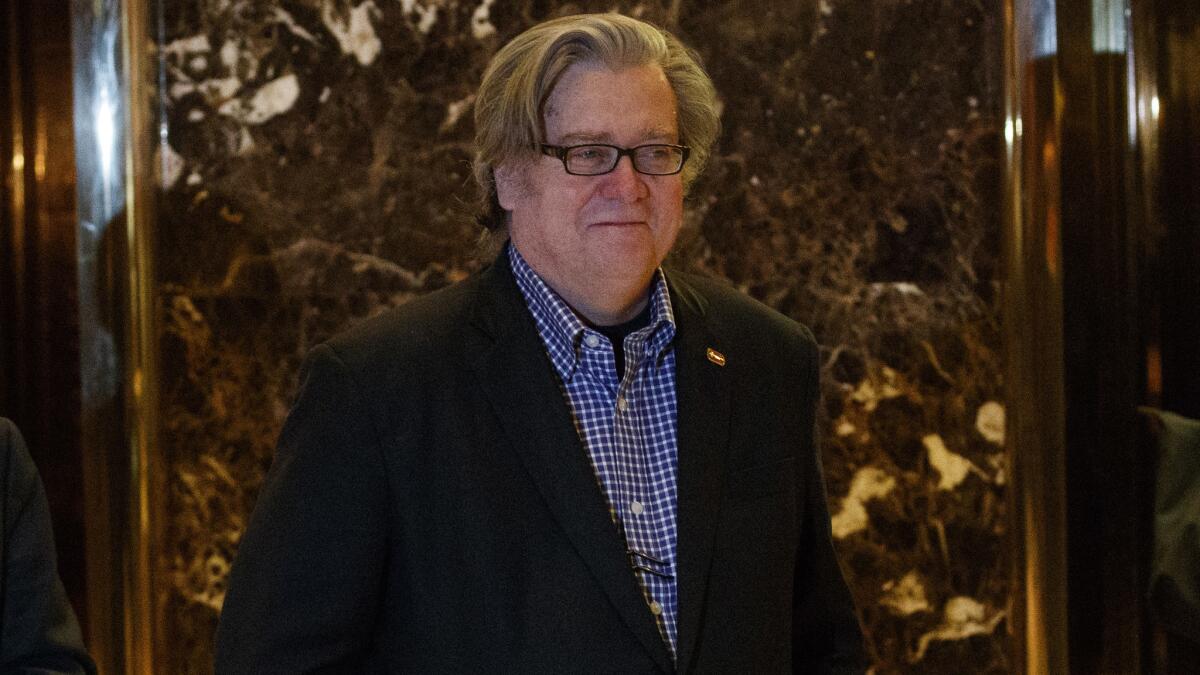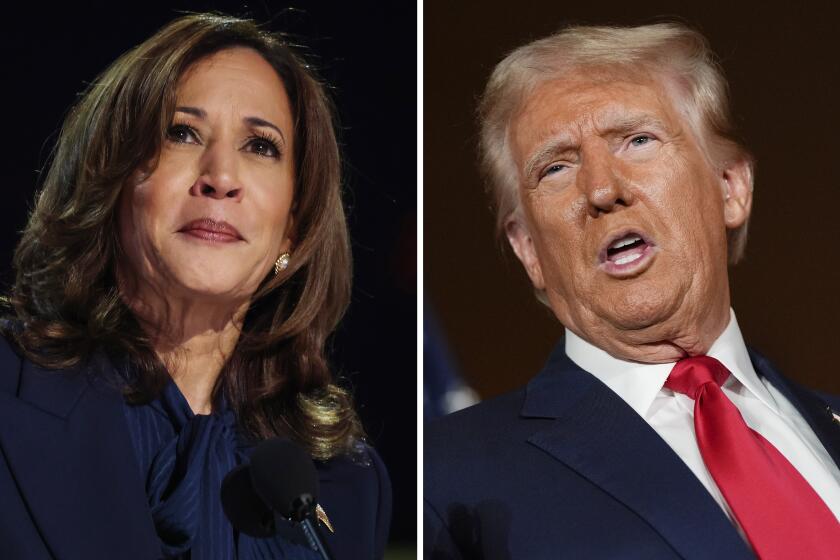White nationalistsâ âman in the White Houseâ? Bannon appointment provokes angry rebukes

Reporting from Washington â Steve Bannon was one of Donald Trumpâs closest confidants and most determined field lieutenants throughout the presidential campaign; now he has become President-elect Trumpâs first major postelection political problem.
The angry backlash against Trumpâs announcement that the Breitbart News executive would serve as his chief White House strategist gave dispirited Democrats and other critics of the president-elect a rallying point Monday. Mainstream Jewish and Muslim groups warned that Trump was elevating an enthusiastic promoter of white nationalism to a desk steps from the Oval Office.
Republican lawmakers â many of whom have their own reasons for disliking Bannon â were not inclined to defend him.
âIâve never met the guy,â House Speaker Paul D. Ryan (R-Wis.) said on CNN, adding that âI trust Donaldâs judgment.â
âI do not know Steve Bannon,â House Majority Leader Kevin McCarthy (R-Bakersfield) said as he repeatedly parried questions from reporters at a news conference Monday morning.
That reluctance to actively defend Trumpâs choice came as no surprise. Bannon is, after all, a man who said in a 2004 interview with the Daily Beast that âI want to bring everything crashing down, and destroy all of todayâs establishment.â
He repeatedly has made clear that he does not exempt the Republican leadership from that desired fate.
The fight over his appointment underscored the continued tension between the party leadership and Trump. The president-elect clearly values Bannonâs strategic advice and relied heavily on him to pilot his campaign in its closing months. But whether Trump can navigate the conflict within the party â and what role Bannon plays in doing so â could be central to whether the new administration can succeed.
All that left Bannon where he has been throughout his career â in a bunker exchanging fire with what he derisively calls the forces of âpolitical correctness.â
Only the stakes had suddenly become much higher.
The rage that many civil rights activists and leaders of minority groups have toward Bannon has been swelling for years, long before Trump brought him into the inner sanctum of his operation.
For many, Bannon personifies the so-called alt-right, which the Anti-Defamation League in a statement Sunday night denounced as âa loose-knit group of white nationalists and unabashed anti-Semites and racists.â Indeed, Bannonâs appointment to Trumpâs campaign this year had drawn praise from former Ku Klux Klan leader David Duke and neo-Nazi organizations.
Bannon, who has been fighting multiculturalism and the country club politics of the Republican Party establishment for years, has been aggressively seeking out rumbles since he was a kid in Richmond, Va., growing up in a house not far from where Democratic vice presidential nominee Tim Kaine lives.
His father, Martin, still lives in the neighborhood. His younger brother, Mike, recently recounted to the local newspaper how he was constantly getting called to the neighborhood pool as a teenager to drag his brother out of a fight.
Bannon signed up for the Navy directly out of college, became an officer, left in 1983 for Harvard Business School, then landed a job at Goldman Sachs. His subsequent years in investment banking made him rich, and Hollywood production credits added yet more intrigue to his biography.
He picked up something else, as well: His experiences with the self-satisfied nature of Americaâs financial and cultural elites made him angry, he says.
âI went to Harvard Business School, worked at Goldman Sachs,â he told a Times reporter in 2010. âI know about elites, I know about the contempt that they hold. They hold the basic heartland of this country in contempt.â
Bannon became a close friend and patron of Andrew Breitbart, and took over operations of his news organization in 2012, when Breitbart died suddenly of heart failure at age 43.
At Breitbart, Bannonâs antagonisms manifested themselves in coverage that routinely referred negatively to Muslims, inner-city minorities and women, among other groups. Often the facts were suspect, as when Breitbart wrote about an extremely flawed pollâs finding that more than half of American Muslims wanted sharia law, or suggested that Hillary Clintonâs aide, Huma Abedin, might be a Saudi operative.
One Breitbart writer declared âAmerica has a Muslim problemâ and made clear he was not talking about extremist Muslims, but all Muslims.
The headline of one Breitbart story screamed: âBirth control makes women unattractive and crazy.â Another headline referred to William Kristol, the editor of the conservative magazine the Weekly Standard and an opponent of Trumpâs, as a ârenegade Jew.â
Journalist Ben Shapiro, a former writer for Breitbart, described it as a platform for âwhite ethno-nationalismâ and a âcesspool for white supremacist meme makers.â
GOP strategist Kurt Bardella, who said he talked to Bannon almost daily for two years while working as Breitbartâs media consultant, described him as âthe ideological driving force behind Breitbart and its content.â
âHe put himself front and center,â said Bardella, who parted ways with Breitbart as the site became something he saw as âtoxic and perpetually malcontent.â
Bannonâs allies, however, call talk of racism outrageous. On Monday, as the denunciations of Bannon mounted, Breitbart employees quickly signed onto what had all the appearances of a traditional crisis-communications exercise, releasing statements painting Bannon as a sensitive and sympathetic employer â even someone who prizes diversity.
That portrait contrasts with the one that emerged in court filings. In 2007, during divorce proceedings, Bannonâs then-wife alleged that he repeatedly made anti-Semitic remarks as the couple toured Los Angeles private schools for their daughters.
She said Bannon had asked the director of the Westland School âwhy there were so many Hanukkah books in the library.â He was concerned that the Willows Community School âused to be in a temple,â she alleged in a court filing.
In a deposition, referring to Bannonâs reaction to another prominent private school, she said that âthe biggest problem he had with Archer is the number of Jews that attend. He said that he doesnât like Jews and that he doesnât like the way they raise their kids to be âwhiny brats,â and that he didnât want the girls going to school with Jews.â
Bannon, who ultimately sent his children to Archer for middle school and high school, has denied ever making any such comments.
âThis is what they will do to anybody who defeats the left, â said Joel Pollak, a Breitbart journalist in California who is an Orthodox Jew.
âThere are no Nazis here, no white nationalists here,â Pollak said, of the Breitbart newsroom. âIf our articles appeal to people beyond our core audience, there is nothing I can do about that.â
âWe are what we have always been,â he said, âa voice for the conservative movement.â
Times staff writers Michael A. Memoli in Washington and Robin Abcarian in Los Angeles contributed to this report.
Follow me: @evanhalper
Domestic violence allegations from 1996 surface against chief of Donald Trumpâs campaign
Donald Trump shakes up campaign by hiring executive from conservative Breitbart News to top post
UPDATES:
5:35 p.m.: This article was updated with background on Bannonâs upbringing and Breitbart News, as well as comments by Breibart journalist Joel Pollak.
This article was originally published at 10:50 a.m.
More to Read
Get the L.A. Times Politics newsletter
Deeply reported insights into legislation, politics and policy from Sacramento, Washington and beyond. In your inbox three times per week.
You may occasionally receive promotional content from the Los Angeles Times.











